The Archaeologist’s Toolkit: What is an Excavation?
Posted on January 24, 2023 by Chelsea Cook
The most popularized aspect of archaeology is the process of excavation. According to Hollywood, it is during excavation when archaeologists break out their shovels and trowels to recover buried treasure from the ground. In reality, excavation is a highly, detailed and structured process. An excavation is the scientific and systematic examination of an archaeological site. Excavations are conducted to define historical contexts and put them in order to produce the history of the site. Depending on the site, excavation units can range from small 1-meter by 1-meter squares to large block excavations.
Though you may think digging is the most important activity during an excavation, it’s really recording an artifact’s context as accurately as possible. This is because excavation is destructive, and the context of that artifact can never be recovered once it is removed from the ground. To preserve context, archaeologists excavate in a controlled manner; sometimes we dig in arbitrary levels, such as 10 cm of coil, or we follow the soil’s natural stratigraphy.
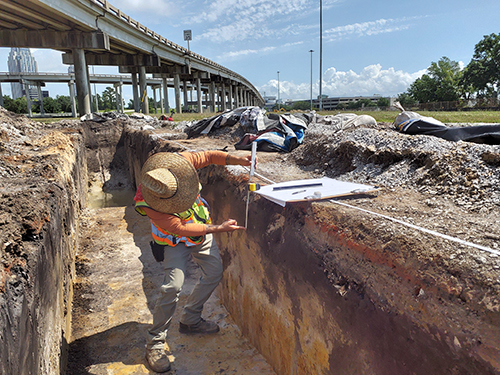
An archaeologist measures layers of soil in a trench for the I-10 Mobile River Bridge Archaeological Project.
Archaeologists typically excavate a site when it has the potential to yield valuable information about the past or when the site is threatened. Currently, we’re working on the I-10 Mobile River Bridge (MRB) Archaeology Project to excavate sites threatened by the bridge widening project. This project is required under the National Historic Preservation Act (NHPA). Under NHPA, federal agencies and projects using federal money must consider impacts to historic properties, like archaeological sites.
When negative impacts are identified, archaeologists often conduct excavations to mitigate them. This allows us to collect as much data as possible from a site before it is impacted. Excavation methods depend on many factors, such the environment, the site’s depth, or the cultural material recorded during the survey, as well as the project time limit and budget. For the I-10 MRB Project, we are primarily employing three methods: Hand excavation, Stripping, and Trenching.
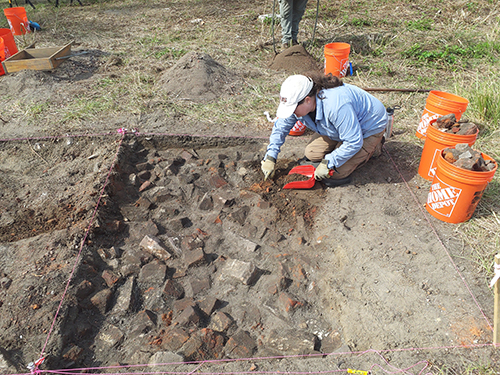
An archaeologist excavating a site for the I-10 Mobile River Bridge Archaeological Project.
Hand excavation (above) is what most people envision when they think of archaeology. It entails digging through layers of soil with a trowel or a shovel and carefully recording the artifacts found in each layer of soil.
Trenching: Long, thin trenches are excavated with heavy machinery to determine a site’s stratigraphy and to help target areas for hand excavation. This method is used when a site is deeply buried or when it encompasses a large area horizontally. For instance, a single site on the MRB project included 6 trenches which measured1.5m wide and varied in length between 15 -22 m.
Stripping: Heavy machinery is used to remove the top layer of soil at a site to reveal archaeological features. The features can then be excavated and mapped. This method is usually employed after the site’s stratigraphy has been defined and the top layer of soil is determined not archaeologically significant; for example, on the I-10 MRB project, the top layers of soil are often comprised of fill from the construction of the interstate. Through stripping, we remove the fill to access the site beneath it.
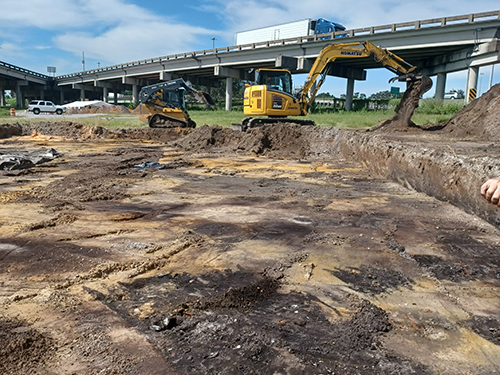
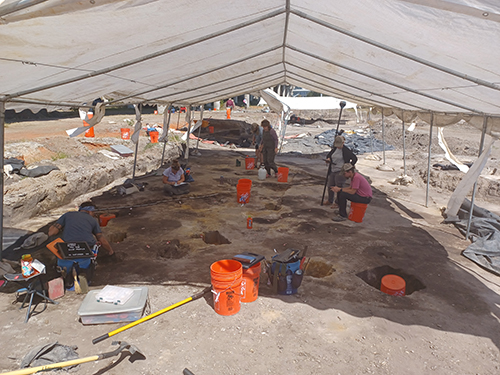
A site is mechanically stripped during the I-10 Mobile River Bridge Archaeological Project (left). A crew excavates and maps features in a stripped area (right). Each hole represents a feature that has been excavated.
After soil is removed from the ground, it is sifted through mesh, leaving any artifacts in the screen (below). This ensures each artifact recovered is collected from the site. The artifacts are recorded, bagged, and tagged with their provenience, or information about where they were found. The artifacts are then sent back to the lab for analysis.
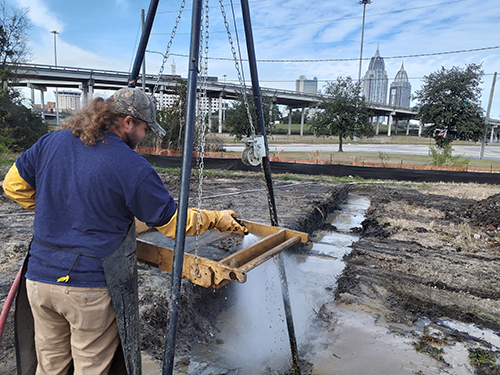 A field crew member screening soil recovered from a site on I-10 Mobile River Bridge
Archaeological Project.
A field crew member screening soil recovered from a site on I-10 Mobile River Bridge
Archaeological Project.
As archaeologists, we have a professional responsibility to analyze all the artifacts and information obtained during the excavation. The next blog will explore what happens to artifacts after they are recovered and brought back to the lab. The Archaeologist’s Toolkit is a blog series written by Chelsea Cook. This series explores archaeological concepts and methods. Check out the posts below to learn more!
What is Archaeological Survey?
Further Reading about excavation:
What do Archaeologists Do?: A brief description of the different techniques employed by archaeologists to gather data provided by the Society for American Archaeology.


